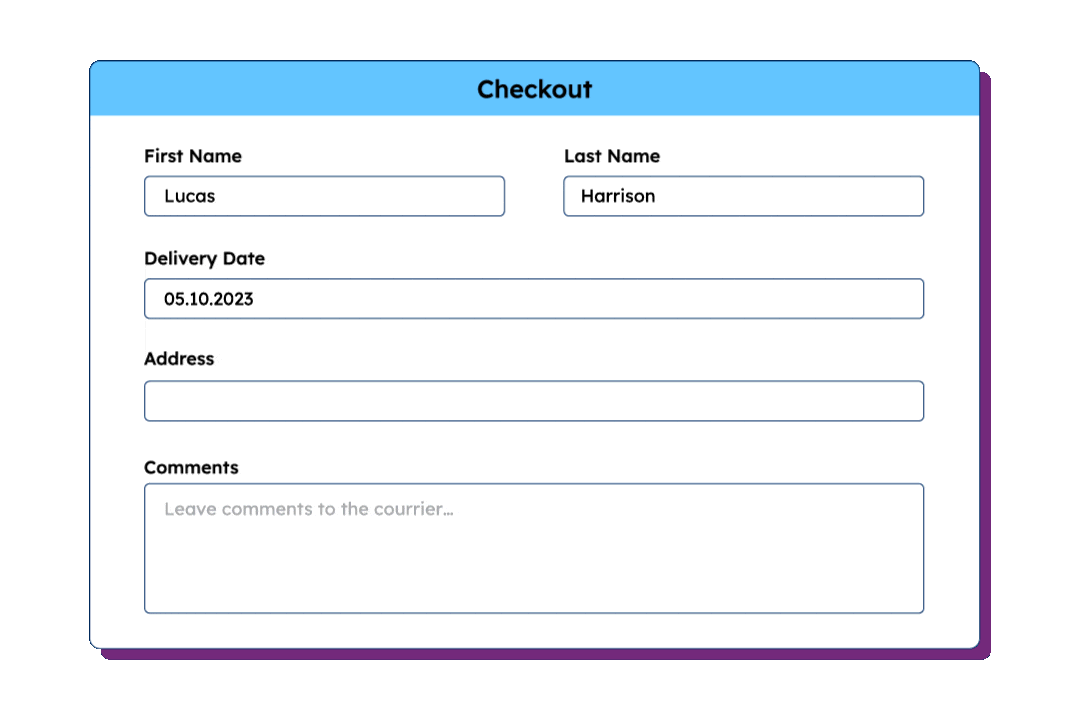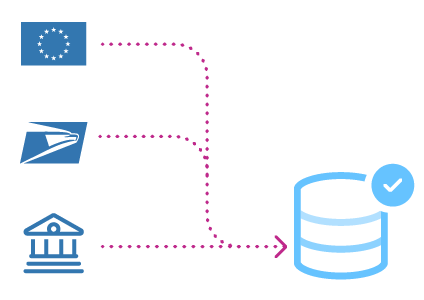Global Address Autocomplete

What is address autocomplete?
Address autocomplete automatically suggests or completes address information in a form, reducing the risk of manual input errors.
- Deliver superior user experience
- Ensure data accuracy
- Increase conversion at checkout
- Prevent shipping problems

Worldwide coverage
247 countries in a standardized database

Unmatched data quality
Our long-standing partnerships with national and international postal operators, such as USPS, guarantee the timely delivery of accurate information.
1,500 verified data sources

City Ranking
Our weighting algorithm considers more than 100 variables to enable filtering and prioritization of the address suggestion options.
Reduce address data entry time
Full customization
Superior User Experience
Multi-Language support
299 languages available

HOW DOES IT WORK
Why using on-premise data for address autocomplete?
Unique expertise to integrate our data into your address autofill
With 15 years of experience in Enterprise integration and an in-depth knowledge of each country’s postal structure, a dedicated expert will ensure a smooth and timely implementation of the data into your system.

“GeoPostcodes addresses the needs of our internal teams and our users thanks to its accuracy, completeness, and multi-language features."
Antoine Pairet
CTO and Co-founder
“Having accurate postal code information available improves the experience of our customers. It saves them time and increases the data quality of their input, lowering the risk of data errors that can cause costly delays."
William Chao
Product Owner, Geographic Information Services
GeoPostcodes has been our go-to partner for our worldwide geodata needs since 2020. Their database is the most comprehensive we've encountered and its quality is unmatched.
Nick Beaugié
Software Engineer
WHY GEOPOSTCODES
Use our data to increase quality, reduce costs
and free up internal resources
Plug and Play Design
- Standardized and unified data structure
- Reduce integration time by 30%
- 299 languages
Highest quality
- 247 countries
- 1,500 verified data sources
- Weekly updates
Enterprise Grade Service
- 100+ successful integrations
- Dedicated Customer Success Manager
- On-premise data
Check other use cases covered by our global location data
Our address autocomplete articles
Frequently Asked Questions
An address autocomplete is a functionality used in online forms and mapping applications to assist users in entering addresses in the right format.
When a user types an address in a form field or search bar, the autocomplete system suggests potential matching results based on relevance or proximity to the user’s location.
The address autocomplete functionality typically leverages a database or an API that contains a vast collection of valid addresses, postal codes, cities, states, and countries. As users begin typing in their address search, the system predicts and suggests potential matches based on the input provided, making it easier for users to select their valid address from the suggestions rather than manually entering the complete address.
Choosing carefully your address autocomplete software is important. For instance, a a user inputs 185, Fift Avenue, although no residence exists with that number on the specified street – with only two existing apartments numbered 183 and 186 – many address autocomplete tools ignore these errors and proceed to fill in the remaining address details.
Consequently, this oversight often results in unsuccessful or undelivered shipments.
The Address autocomplete validation process ensures that users receive suggestions as they type, and validate the correct address data to ensure it is real and accurate.
This validation process checks aspects such as:
- Presence of typos or misspellings in street address
- Existence of the address in a valid postal or mapping database
- Formatting of the address being properly standardized to match postal standards
Address Autofill and Address Autocomplete are closely related concepts, but they have some data sourcing differences:
Address Autofill
Address Autofill typically refers to the automatic population of address fields in a form by filling in address details based on information the user has previously provided or saved in their profile. It doesn’t necessarily involve real-time suggestions or predictions as the user types. It is commonly used in e-commerce websites, online checkout processes, and address entry forms.
Address Autocomplete
Address Autocomplete provides real-time address suggestions based on the characters entered by the user. This can be especially useful when users are unsure of the exact address format or need to choose from multiple possible addresses. It helps reduce errors and improve the accuracy of address data entry.
These concepts are not the be confused with address verification which is ensuring an address is connected to the individual who provided it. An address verification software can be useful in this case.
One disadvantage of address autocomplete is the potential for privacy concerns. Here’s how address autocomplete can be a privacy issue:
- To provide address autocomplete functionality, many applications and websites may collect and store user input data, including the addresses users are typing or selecting.
- Address autocomplete may also have location-based functionality, which means it may have access to a user’s real-time location. This can be concerning for users who are wary of sharing their location with applications or websites.
- Some
address autocomplete services may share user data with third-party entities, which can raise additional privacy concerns if users are not aware of or have not consented to such data sharing.
GeoPostcodes databases are 100% GDPR compliant, to ensure your location data follows all data regulations in force.
We can help you with address autocomplete service.
Address autocomplete is a valuable tool that enhances the user experience and improves data accuracy. Its ability to simplify the address entry process makes it a widely adopted feature in many online applications and services using address forms.
Some of the main benefits are:
- Efficiency: Address autocomplete speeds up the process of entering information in address forms or applications, reducing the likelihood of misspelling, which can lead to delivery issues and cost increases.
- Data Quality: By suggesting a correct address in real-time, address autocomplete helps reduce errors and inaccuracies.
- Increased Conversions: It enhances the user experience by simplifying the address entry process. A smooth and efficient address entry process will lead to higher completion rates.
- Standardization: Address autocomplete often enforces standardized formatting and conventions, ensuring that addresses adhere to postal or mapping standards.
Adding an address autocomplete feature to your system is a game changer. Check our blog to learn how to build an autocomplete address API free.
While both processes are important for address data collection, Address autocomplete and Address validation work on different stages of the data entry process:
Address autocomplete: Address autocomplete streamlines the data entry process by suggesting standardized format matches based on the address input of a user. While address autocomplete offers suggestions, it may not validate the accuracy of the entered address
Address validation: Address validation focuses on verifying and ensuring the accuracy and completeness of the address captured by the autocomplete form (among other sources). It confirms that the provided address exists in a valid postal or mapping database and adheres to formatting and standardization rules. It is crucial for preventing address-related errors, such as typos or incomplete addresses, that can lead to delivery problems, returned mail, or inaccurate location data.








